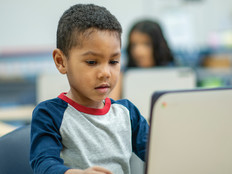Bringing Datacasting from Emergency Comms to K–12 Classrooms
Last year, South Carolina became the first state in the nation to leverage the broadcasting mechanism for remote education. Working with South Carolina Educational Television (SCETV) and datacasting technology company SpectraRep, the state launched the new education initiative, which relies on datacasting to bridge the digital divide and all students — including those without internet access — have the resources needed to succeed. Fairfield County School District, Jasper County School District and York School District One are among the first school districts in the state piloting the new datacasting system.
Other states are following suit. In Indiana, Indiana Public Broadcasting Stations (IPBS), a nonprofit consortium of 17 public radio and television stations, is deploying its program through WTIU Public Television in Bloomington, Ind., and Jennings County Schools. Likewise, Pennsylvania PBS, which comprises the Keystone State’s 7 public television stations, implemented phase one of its own datacasting initiative in December 2020.
With datacasting, school IT teams can transmit remote education resources and instructional content to students even if they lack internet access. Content can be pushed to any wireless device, including tablets and laptops, similar to how law enforcement and emergency services departments broadcast Amber alerts or weather warnings. In South Carolina, for instance, SCETV’s broadcast signals cover 98 percent of the state, allowing schools to reach even the most remote students. School administrators and teachers can leverage this resource to distribute lectures, test scores, grades and handouts for e-learning.
“It is something that has been used for public safety for at least a decade now,” Stephanie Frazier, SCETV vice president of education, told WBTV. “As it relates to education, it is a new concept.”
DISCOVER: The technologies that empower hybrid learning.
How an Old Technology Found New Purpose in Education
Since its inception, datacasting has been a useful tool for news stations and government agencies, thanks to its ability to transmit emergency response and public safety communications to unlimited recipients without relying on internet access or bandwidth.
In 2015, the U.S. Department of Homeland Security’s Science and Technology Directorate’s First Responders Group began using datacasting to transmit encrypted incident response data to first responders in the field. Similarly, SpectraRep uses datacasting for emergency communications at several K–12 student campuses, including schools in Las Vegas.
With this broadcasting mechanism, privacy is a main focus. Content is sent over a secure network to safeguard information and prevent data breaches, ransomware attacks and other cyber threats.
“Content that is delivered through datacasting is also encrypted and targeted to ensure broadcast transmission privacy and security,” Jeremy Cauthen, SCETV’s director of communications, told K–12 Dive.
With the emergence of distance learning, datacasting has found a new foothold in K–12 education, where protecting student data is crucial. From PowerPoint presentations to video files, any file type can be transmitted through a datacasting system, meaning teachers can customize engaging lesson plans using a variety of formats and online resources.
The Building Blocks of a Successful Datacasting Program
Datacasting consists of three steps: content creation and packaging, content encryption and content transmission.
In the first stage, education stakeholders create and package content for their students. To encourage a personalized learning experience, the system supports any type of file, including JPG, PDF and MP4 files, Word documents and various online resources. SCETV’s pilot program, for example, gives educators access to almost 9,000 media assets through KnowItAll.org and PBS LearningMedia.
Next, that content is encrypted and transmitted to a public broadcasting agency, such as PBS. Finally, the encrypted data is transmitted to targeted student devices. To receive files through datacasting, students need a Wi-Fi-enabled device, an antenna and a receiver. In the South Carolina pilot program, districts provide students with the antenna and receiver for free.











